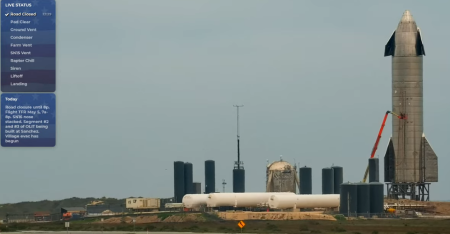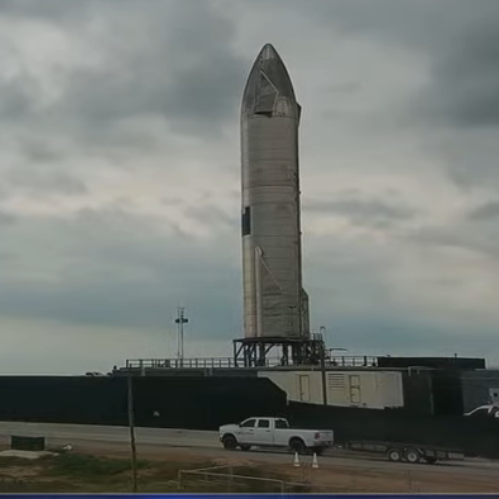SpaceX begins stacking Superheavy prototype for flight
Capitalism in space: It appears that the third Superheavy prototype, BN3 (Booster #3), is now being stacked and prepared for the first near-orbital flight of Starship, which SpaceX is still hoping to launch before the end of this year.
SpaceX has at least six BN3 sections – amounting to 22 rings and two of three tank domes – either completed or awaiting integration. The process of stacking BN3 began sometime in the last 7-10 days when SpaceX joined two four-ring sections – including the booster’s common dome, likely pictured above.
SpaceX has mostly completed BN3’s engine section, including a thrust dome with plumbing cutouts for a full 28 Raptor engines. Most recently, what looks like a Super Heavy fuel manifold appeared in Boca Chica. That manifold will attach to the end of a supersized Super Heavy transfer tube – also spotted in work – used to route methane through the liquid oxygen tank to fuel its Raptor engines. Fueling 28 large, high-performance Raptors is no mean feat and requires a rat’s nest of plumbing to feed them more than 15 metric tons (~30,000 lb) of propellant every second at full throttle.
Put simply, a majority of Super Heavy booster BN3’s hardware appears to be ready or almost ready for integration. The eight rings now stacked represent approximately 20% of the rocket’s full height, leaving another 30 or so rings – 54m (~180 ft) – to go.
That flight, the flight plan of which has already been submitted to the FCC, would take off from Boca Chica, circle about three-quarters of the globe, and land in the Pacific to the northwest of Hawaii. While not a full orbit, this flight would demonstrate an orbital capability while allowing for a controlled safe re-entry at a planned location, a wise approach for that first orbital attempt.
Capitalism in space: It appears that the third Superheavy prototype, BN3 (Booster #3), is now being stacked and prepared for the first near-orbital flight of Starship, which SpaceX is still hoping to launch before the end of this year.
SpaceX has at least six BN3 sections – amounting to 22 rings and two of three tank domes – either completed or awaiting integration. The process of stacking BN3 began sometime in the last 7-10 days when SpaceX joined two four-ring sections – including the booster’s common dome, likely pictured above.
SpaceX has mostly completed BN3’s engine section, including a thrust dome with plumbing cutouts for a full 28 Raptor engines. Most recently, what looks like a Super Heavy fuel manifold appeared in Boca Chica. That manifold will attach to the end of a supersized Super Heavy transfer tube – also spotted in work – used to route methane through the liquid oxygen tank to fuel its Raptor engines. Fueling 28 large, high-performance Raptors is no mean feat and requires a rat’s nest of plumbing to feed them more than 15 metric tons (~30,000 lb) of propellant every second at full throttle.
Put simply, a majority of Super Heavy booster BN3’s hardware appears to be ready or almost ready for integration. The eight rings now stacked represent approximately 20% of the rocket’s full height, leaving another 30 or so rings – 54m (~180 ft) – to go.
That flight, the flight plan of which has already been submitted to the FCC, would take off from Boca Chica, circle about three-quarters of the globe, and land in the Pacific to the northwest of Hawaii. While not a full orbit, this flight would demonstrate an orbital capability while allowing for a controlled safe re-entry at a planned location, a wise approach for that first orbital attempt.








